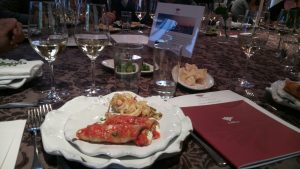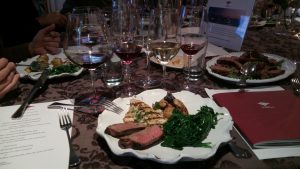If you have had Italian wine before, (and most of us have) chances are, you have had a Pinot Grigio or a Merlot. Or probably both. These two international varietals are among the most famous and highly regarded wine grapes in the world and they are planted not only in Italy but in most of the wine producing world. The citrus and orchard fruit driven flavors, balanced acidity, (and depending on the style), the floral and honeysuckle character of a good Pinot Grigio gives it wide appeal. Merlot offers notes of fresh cherries, berries and red fruit, a soft and balanced oak character (and sometimes) coffee, chocolate and vanilla characteristics. If you have explored what Italian wine country has to offer further, no doubt you have had Sangiovese, one of Italy’s most important red wine grapes. Both Brunello di Montalcino and Chianti Classico produced in Tuscany are made from Sangiovese grapes.
Another very important Italian grape variety that is lesser known but worthy of attention is Vermentino. If Vermentino can be compared with another white wine varietal, it would be Sauvignon Blanc. Like Sauvignon Blanc, Vermentino can be fresh, zesty and floral, with lively citrus and orchard fruit notes, along with mineral and saline elements and a crisp acidity. It can also be more full-bodied and demonstrate a subtle nuttiness depending on the style of production. Vermentino is grown on the island of Sardinia which lies to the west of Italy. Sardinia is Italy’s second largest island, and although a part of Italy, geographically closer to the French island of Corsica, than it is to Italy. Nevertheless, when it comes to culture, food and wine, Sardinia is every bit as Italian as Sicily, or Rome or Naples, for that matter.
Surrounded by the clear blue warm waters of the Mediterranean Sea, The Emerald Coast of Sardinia draws throngs of tourists to its pristine beaches every year. Sardinia is also prime wine producing country. Four principal grapes are grown in Sardinia including Vermentino, Carignan, Cannonau and Bovale Sardo.

Family-owned Vigne Surrau, situated in Gallura, and named after the valley and the river that help to define the terroir from which their wines are created, has been making wine for fifteen years with a family tradition of agriculture to help guide them. The winery, constructed of wood, stone and glass stands on fifty hectares against a backdrop of mountains and blends harmoniously with the verdant Easternmost Gallura landscape around it. The vineyards, located a few miles from the Emerald Coast, benefit from the granite sands in the Juannisolu and Capichera hills and the clay rich soils of the Pastura and Cascioni plains. The Mistral winds coming off the Strait of Bonifacio help to cool the sun drenched valley.
Vigne Surrau brought the fruits of its vineyard to Palma Carriage House in the West Village, New York City on October 26, 2016. The warm, rustic and inviting Italian restaurant, well crafted Italian and Mediterranean cuisine, and notable selection of whites and reds from Vigne Surrau were the perfect combination through which to showcase what Sardinian vines can yield.

A first course duo of lightly fried batter dusted calamari and eggplant rollatini was served with a pair of Vermentino. The Branu, Vermentino di Gallura DOCG, 2015 was fresh, well rounded and full of ripe green apple, citrus and pear notes and it worked particularly well with the calamari. The Sciala, Vermentino di Gallura DOCG, Superiore, crafted from a selection of the best grapes from the harvest, had rich tropical and orchard fruit notes and balanced out the subtle roasted flavors of the eggplant rollatini and enhanced the mild sweetness of the ricotta. Both wines are fermented in stainless steel giving them a freshness and a balanced acidity.

A second course of pappardelle tossed with shitake mushrooms was paired with two reds including a Sincaru, Cannonau di Sardegna DOC, 2014 with bright raspberry, cherry, plum and spicy notes, and a Sincaru, Cannonau di Sardegna DOC Riserva, 2013 with rich ripe cherry and spice notes. The Sincaru, Cannonau di Sardegna DOC Riserva, 2013 worked particularly well with the pasta and blended seamlessly with the pungent and slightly smoky flavors of the mushrooms. The first vintage is aged in concrete tanks while the second undergoes two years of aging in oak.

The third course presented included a flaky and moist grilled Italian sea bass seasoned in olive oil, lemon and herbs. The citrus fruit flavors of the Branu worked best with this delicate dish. Surprisingly, the Sincaru also made a nice complement; the wine had a fresh, fruit driven character that did not overpower the mild flavors of the fish. A tender grilled steak was also served, and here, the Sincaru Riserva shined, bringing out the hearty and earthy flavors of the grilled meat.

Be First to Comment